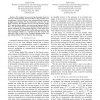Free Online Productivity Tools
i2Speak
i2Symbol
i2OCR
iTex2Img
iWeb2Print
iWeb2Shot
i2Type
iPdf2Split
iPdf2Merge
i2Bopomofo
i2Arabic
i2Style
i2Image
i2PDF
iLatex2Rtf
Sci2ools
CORR
2007
Springer
2007
Springer
Achievable Rates for Two-Way Wire-Tap Channels
—We consider two-way wire-tap channels, where two users are communicating with each other in the presence of an eavesdropper, who has access to the communications through a multiple-access channel. We find achievable rates for two different scenarios, the Gaussian two-way wire-tap channel, (GTWWT), and the binary additive two-way wire-tap channel, (BATWWT). It is shown that the two-way channels inherently provide a unique advantage for wire-tapped scenarios, as the users know their own transmitted signals and in effect help encrypt the other user’s messages, similar to a one-time pad. We compare the achievable rates to that of the Gaussian multiple-access wiretap channel (GMAC-WT) to illustrate this advantage.
| Added | 13 Dec 2010 |
| Updated | 13 Dec 2010 |
| Type | Journal |
| Year | 2007 |
| Where | CORR |
| Authors | Ender Tekin, Aylin Yener |
Comments (0)

